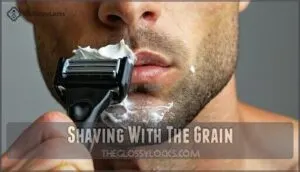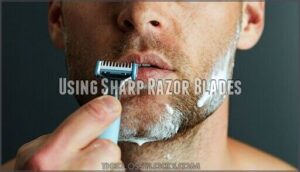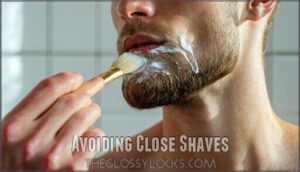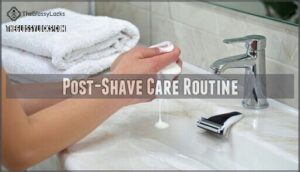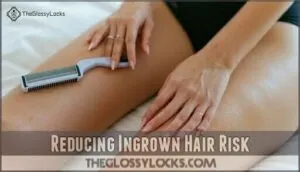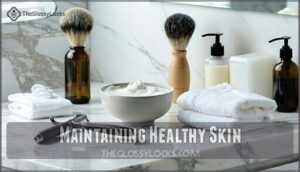This site is supported by our readers. We may earn a commission, at no cost to you, if you purchase through links.
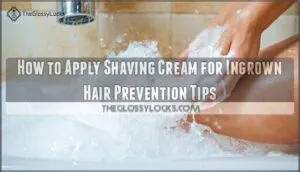
Apply a generous layer of moisturizing shaving cream, then let it sit for 1-2 minutes before shaving.
This waiting period is essential—it allows the cream to penetrate and soften coarse hairs that might otherwise curl back into your skin.
Use circular motions when applying to lift hairs away from the surface.
Don’t skimp on the product; a thin layer won’t provide enough protection against razor burn and irritation.
The right application technique sets the foundation for bump-free skin, but there’s more to the story.
Table Of Contents
- Key Takeaways
- Preventing Ingrown Hairs
- Applying Shaving Cream Correctly
- Shaving Techniques Matter
- Post-Shave Care Routine
- Reducing Ingrown Hair Risk
- Maintaining Healthy Skin
- Frequently Asked Questions (FAQs)
- How to prevent ingrown hairs after shaving cream?
- How to avoid pubic ingrown hairs when shaving?
- Can I use aftershave with shaving cream for ingrown hairs?
- Can I use moisturizer as a substitute for shaving cream?
- Can I use shaving cream for ingrown hairs on my face?
- Can shaving cream expire or go bad?
- How much shaving cream should I use?
- Should I rinse shaving cream completely off?
- Can I use shaving cream on sensitive areas?
- Does shaving cream work for all hair types?
- Conclusion
Key Takeaways
- Prepare your skin properly – Soften hair with warm water for 3 minutes, then apply a generous layer of shaving cream using circular motions and let it sit for 1-2 minutes before shaving.
- Choose the right technique – Always shave with the grain using sharp, single-blade razors with gentle pressure to prevent cutting hair too short and creating jagged edges.
- Don’t skip post-shave care – Apply alcohol-free aftershave immediately, then moisturize daily with products containing hyaluronic acid or ceramides to keep follicles clear.
- Maintain consistent prevention habits – Exfoliate 2-3 times weekly with gentle scrubs or salicylic acid, avoid tight clothing after shaving, and stay hydrated to keep your skin barrier strong.
Preventing Ingrown Hairs
You can substantially reduce ingrown hairs by properly preparing your skin and applying shaving cream correctly before each shave.
The right techniques create a protective barrier that helps your razor glide smoothly while preventing hair from growing back into your skin, which is a key factor in reducing ingrown hairs.
Exfoliating Before Shaving
Before shaving, exfoliate your skin to remove dead cells that can clog hair follicles and trap growing hairs.
Use gentle physical exfoliation with a scrub or chemical exfoliants like salicylic acid twice weekly. This exfoliation frequency prevents ingrown hair formation while preparing sensitive skin for smoother shaving.
Proper exfoliation benefits include clearer pores and reduced irritation during your shaving routine.
For sensitive skin, consider using chemical exfoliators like AHAs and BHAs.
Choosing Right Shaving Cream
Why settle for basic when the right shaving cream ingredients can transform your routine?
Look for glycerin, aloe vera, and natural oils that create protective barriers while softening hair. These cream benefits include reduced razor burn and smoother glides.
For sensitive skin, choose fragrance-free formulas with chamomile or oatmeal. Quality shaving cream alternatives beat foam every time.
For those with sensitive skin, non-foaming creams are often recommended.
Softening Hair Before Shaving
Most people rush through shaving, but smart preparation makes all the difference.
Before applying shaving cream, soak your skin in warm water for three minutes—this opens pores and softens hair fibers substantially.
Pre-shave oils and hair conditioners work wonders too, creating a protective barrier that prevents razor drag.
Steaming benefits include reduced friction during shaving cream application, while towel application of heat maximizes hair softening for effective ingrown hair prevention.
Applying Shaving Cream Correctly
Starting with proper skin preparation sets the foundation for effective shaving cream application and successful ingrown hair prevention.
You’ll want to cleanse your skin thoroughly, removing dirt and oils that can interfere with product absorption.
Apply shaving cream to damp skin using these essential steps:
- Cream Application Amount: Use a quarter-sized portion for your face, adjusting based on the area you’re shaving
- Circular Motions: Work the cream into your skin using gentle circular movements to lift hair and create a protective barrier
- Pre-Application Prep: Let the cream sit for 30-60 seconds to fully soften hair before shaving
- Sensitive Skin Formulas: Choose alcohol-free, fragrance-free options if you have reactive skin
This shaving technique guarantees even coverage while avoiding product waste.
Proper shaving cream application creates the ideal environment for smooth hair removal, reducing friction that leads to ingrown hairs.
The circular motion helps exfoliate dead skin cells while the waiting period allows maximum hair softening for cleaner cuts.
Shaving Techniques Matter
Your shaving technique directly impacts whether you’ll face painful ingrown hairs or enjoy smooth, irritation-free skin.
The way you hold your razor, the direction you shave, and how much pressure you apply can make the difference between a comfortable shave and weeks of dealing with angry red bumps, which is influenced by your shaving technique.
Shaving With The Grain
The secret to preventing ingrown hairs lies in following your hair’s natural path.
When you shave with the grain, you’re working with your hair growth direction, not against it. This gentle shaving technique reduces skin irritation and helps you avoid razor bumps by maintaining the proper blade angle throughout your shave.
A key aspect involves understanding progressive beard reduction for a more thorough shave.
| Hair Growth Direction | Shaving Technique | Expected Results |
|---|---|---|
| Face (downward) | Shave top to bottom | Reduced skin irritation |
| Legs (upward) | Shave bottom to top | Fewer razor bumps |
| Underarms (multiple) | Follow natural patterns | Smoother finish |
| Bikini area (varies) | Map growth first | Less inflammation |
| Neck (upward/sideways) | Use short, careful strokes | Minimal ingrown hairs |
Using Sharp Razor Blades
Sharp blades slice hair cleanly, preventing jagged edges that curl back into skin. Dull razors require multiple passes, increasing razor bumps and irritation.
Sharp blades cut clean—dull ones create the jagged edges that become tomorrow’s ingrown hairs.
Replace blades after 5-7 shaves for maximum blade sharpness impact. Sharp razor type matters – they glide smoothly with proper blade angle control.
Replacing blades often reduces skin irritation by 47%. Quality shaving cream enhances blade performance, minimizing ingrown hairs while supporting healthy hair growth direction.
Proper shaving helps prevent pseudofolliculitis, or razor bumps, which is a key factor in achieving a smooth shave with minimal irritation.
Avoiding Close Shaves
While sharp blades matter, avoiding close shaves prevents ingrown hairs more effectively.
Don’t stretch skin during shaving, as this creates improper razor angle and cuts hair too short.
Single-blade razors with gentle pressure control work best, and your shaving cream helps maintain proper shaving technique and direction.
Limit shave frequency to twice weekly, allowing hair follicles to recover, which is crucial for preventing ingrown hairs and maintaining proper shaving technique.
Post-Shave Care Routine
Your shaving routine doesn’t end when you rinse off the foam—the real work begins afterward.
Proper post-shave care creates a protective barrier that prevents irritation and keeps those pesky ingrown hairs from forming in the first place, which is a key part of a good shaving routine to achieve smooth skin.
Applying Soothing Aftershave
After mastering proper shaving techniques, you’ll want to apply soothing aftershave immediately while skin remains damp.
Ingredients matter – choose alcohol-free formulas with aloe vera, witch hazel, or chamomile to reduce redness and prevent irritation.
Application techniques involve gentle massage over freshly shaved areas, avoiding broken skin.
Using alcohol-free products can help prevent irritation.
This aftershave care helps with ingrown hair prevention by calming sensitive skin and creating a protective barrier against razor bumps.
Moisturizing to Hydrate Skin
After soothing your skin with aftershave, moisturizing becomes your next line of defense against ingrown hairs.
Post-shave hydration replenishes moisture lost during shaving, strengthening your skin barrier and preventing dead cells from clogging follicles.
Choose moisturizers with hydrating ingredients like hyaluronic acid or ceramides.
Apply daily, focusing on recently shaved areas to maintain ideal skin hydration and maximize ingrown hair prevention.
Consider using aloe vera’s benefits to soothe irritation and promote healing.
Exfoliating Regularly
While hydrating your skin helps, regular exfoliation prevents dead skin cells from clogging hair follicles and trapping growing hairs.
Choose between physical exfoliation with gentle scrubs or chemical exfoliants containing salicylic acid for sensitive skin. Maintain proper exfoliation frequency—2-3 times weekly—to keep pores clear without causing irritation.
- Physical Exfoliation: Use gentle scrubs with fine particles or exfoliation tools like loofahs 2-3 times weekly
- Chemical Exfoliants: Try salicylic acid-based products for sensitive skin and deeper pore cleansing
- Exfoliation Frequency: Stick to every other day to prevent over-exfoliation and skin irritation
- Skin Exfoliation Methods: Combine exfoliating before shaving with regular post-shave skin exfoliation routines
Reducing Ingrown Hair Risk
Beyond proper shaving cream application, you can further reduce ingrown hair risk by exploring alternative hair removal methods like IPL devices or electric shavers that don’t create sharp hair edges.
You’ll also want to avoid tight clothing after shaving and maintain consistent skin hydration to keep follicles clear and healthy, using methods that promote healthy skin.
Using Alternative Hair Removal
Consider alternative hair removal methods for long-term ingrown hair prevention.
Laser hair removal destroys up to 90% of follicles, dramatically reducing ingrown hair recurrence.
Waxing benefits include smoother results but may still cause ingrowns.
Threading accuracy works well for facial areas.
Depilatory concerns involve potential skin irritation.
Electrolysis cost varies but offers permanent results.
IPL effectiveness provides lasting smoothness without sharp regrowth edges, which contributes to long-term ingrown hair prevention.
Avoiding Tight Clothing
Tight clothing creates friction against freshly shaved skin, increasing ingrown hair risk.
Choose breathable fabrics like cotton over synthetic materials that trap moisture and heat.
Loose-fitting garments improve circulation impact and reduce post-shave comfort issues.
When selecting clothing materials after hair removal, prioritize friction reduction over fashion, as your skin needs breathing room to heal properly and prevent irritation that leads to ingrown hairs.
Keeping Skin Hydrated
Well-hydrated skin acts like a protective shield, preventing dead cells from trapping hair beneath the surface.
**Proper hydration creates the foundation for ingrown hair prevention by keeping follicles clear and healthy.
When your skin lacks moisture, it becomes rough and creates perfect conditions for ingrown hairs to develop after shaving.
Hydration Routine essentials:
- Moisturizer Types matter – Use non-comedogenic lotions with Humectants Explained like hyaluronic acid that draw water into skin cells
- Internal Hydration counts – Drink plenty of water daily to support your skin’s natural moisture barrier from within
- Hydration Benefits multiply – Apply moisturizer twice daily, especially after showering when skin absorbs products better
This skin hydration techniques approach works hand-in-hand with quality shaving cream benefits for thorough ingrown hair prevention.
Using coconut oil offers natural moisturizing benefits.
Maintaining Healthy Skin
Your skin needs the right care to prevent ingrown hairs, and avoiding harsh chemicals helps maintain its natural protective barrier.
Regular monitoring lets you catch potential issues early, keeping your skin healthy and smooth after every shave.
Avoiding Harsh Chemicals
You’ll protect your skin by choosing shaving cream with natural ingredients instead of harsh chemical irritants.
Sensitive skin thrives with organic options and hypoallergenic creams that won’t trigger reactions.
Skip products loaded with artificial fragrances, sulfates, and alcohol that can worsen skin irritation.
Fragrance-free products reduce your risk of developing ingrown hairs while keeping your skin calm and comfortable during shaving with hypoallergenic creams.
Monitoring Skin for Ingrown Hairs
Regular checkups of your skin act like a safety net, helping you catch ingrown hairs before they become problematic.
Visual inspection after shaving reveals early detection signs like small bumps or redness around hair follicles.
Look for inflammation signs including swelling, tenderness, or pus-filled bumps that signal skin irritation.
Quick identification enables prompt ingrown hair treatment, preventing scarring and reducing skin inflammation risks.
Frequently Asked Questions (FAQs)
How to prevent ingrown hairs after shaving cream?
Ironically, shaving cream’s job isn’t done once you’ve applied it—what happens afterward determines whether you’ll face ingrown hairs.
Shave with the grain, use single-blade razors, exfoliate regularly, and moisturize post-shave for smooth results, including to prevent ingrown hairs by following these steps.
How to avoid pubic ingrown hairs when shaving?
Shave with the grain using a sharp single-blade razor after exfoliating. Apply quality shaving cream, avoid stretching skin, and don’t over-shave the same area to prevent irritation.
Can I use aftershave with shaving cream for ingrown hairs?
Yes, you can use aftershave with shaving cream for ingrown hair prevention.
Apply shaving cream first to soften hair and protect skin, then use alcohol-free aftershave balm post-shave to soothe and moisturize the area.
Can I use moisturizer as a substitute for shaving cream?
While moisturizer can’t replace shaving cream’s protective lubricating properties, it won’t prevent ingrown hairs effectively.
Shaving cream softens hair, creates friction barriers, and contains exfoliating ingredients that moisturizer lacks for proper shaving, making it a more suitable choice with protective properties.
Can I use shaving cream for ingrown hairs on my face?
You can use shaving cream on your face to prevent ingrown hairs.
It softens facial hair, creates a protective barrier, and reduces friction that causes hairs to grow back into your skin, which can be considered a complete solution to the problem of ingrown hairs.
Can shaving cream expire or go bad?
Most shaving creams last 2-3 years unopened, but they can expire and lose effectiveness.
You’ll notice changes in texture, smell, or color when they’ve gone bad, potentially increasing irritation and reducing protection against ingrown hairs.
How much shaving cream should I use?
Use about a quarter-sized amount of shaving cream for your face, or roughly one teaspoon.
This provides adequate lubrication without wastage, creating a protective barrier that prevents razor drag and reduces ingrown hair formation.
Should I rinse shaving cream completely off?
Yes, rinse thoroughly after shaving. Leftover cream can clog pores and trap hair, leading to ingrown hairs. Clean skin allows follicles to breathe and heal properly.
Can I use shaving cream on sensitive areas?
Picture delicate skin meeting a sharp blade – that’s where trouble begins.
You can definitely use shaving cream on sensitive areas, but choose formulas designed for delicate skin with soothing ingredients like aloe vera to prevent irritation and ingrown hairs.
Does shaving cream work for all hair types?
Most shaving creams benefit all hair types, but coarse or curly hair needs extra-lubricating formulas. You’ll get better results matching your cream to your hair’s thickness and texture.
Conclusion
Mastering how to apply shaving cream for ingrown hair prevention requires patience, proper technique, and consistent care.
You’ll prevent painful bumps by preparing your skin, choosing quality products, and following gentle shaving methods.
Remember to exfoliate regularly, moisturize daily, and avoid rushing through your routine.
These simple steps protect your skin from irritation and keep ingrown hairs at bay, resulting in smooth skin.
Consistent application makes the difference between healthy skin and frustrating razor bumps.
- https://gillette.com/en-us/shaving-tips/how-to-shave/razor-bumps
- https://www.plisson1808.com/en/nos-conseils/news/shaving-how-to-prevent-ingrown-hair
- https://www.trulybeauty.com/blogs/hair/how-to-prevent-ingrown-hairs-after-shaving
- https://lane44.com/blogs/bumps-burns-ingrowns/5-reasons-why-natural-shaving-cream-is-your-secret-weapon-against-shaving-rash-and-ingrown-hairs
- https://grownmanshave.com/blogs/grown-man-shave-society-articles/the-best-shaving-cream-for-sensitive-skin-a-comprehensive-guide

